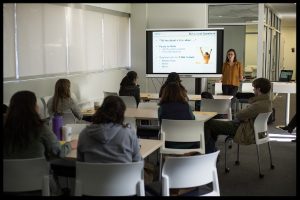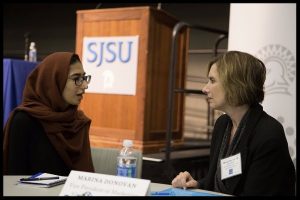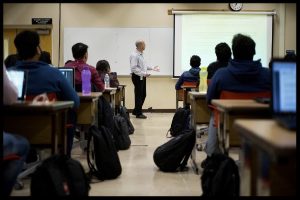
Photo: James Tensuan
Connie L. Lurie College of Education students gather in the Student Success Center for a career advice session.
By Barry Zepel
Technology continues to enhance more and more of the classrooms of San Jose State University. Outdated classrooms have transitioned into 21st-century learning spaces, one of the goals of the Vision 2017 strategic plan.
More “smart” classroom are – or are scheduled to become – operational across campus during the spring semester. Modernization has been an ongoing project for several years within the Connie L. Lurie College of Education, according to Mary McVey, a former associate dean who directed the changes in classrooms and other facilities. She reports that with the installation of modern mobile furniture and “state-of-the-art” technology, 14 old-style classrooms have been converted into “smart” learning spaces. Added to those updates are a student collaboration lab, a faculty-staff meeting and professional development room, and a conference room.
“We were the first at SJSU to redesign our classrooms so that they were fully mobile and based on a 360-degree classroom concept,” said McVey, who recently returned to duties as a full-time professor of child and adolescent development. “The idea is there is no front, back, or sides of the room. All walls are used for active instruction and the instructor is able to move freely about the room rather than being restricted to the front or ‘sage on stage’ position. All of our furniture is mobile so that the rooms can be easily and quickly reconfigured to suit the mode of instruction.”
The newest of the facilities in Education, a Student Success Center (SSC), opened this spring. Whereas other colleges have utilized their centers for academic advising, Education will use its SSC for career counseling of its predominately-graduate level students.
“Unlike the other colleges, two-thirds of our students are at the graduate level,” said Michele Burns, who is coordinator of the SSC for Education. “Most of our students are working on their teaching credential or preparing to become school counselors, speech pathologists and education administrators.
In some cases, students will be able to check out equipment that includes a new supply of 75 iPads and five swivel cameras, mini robotic video devices that move to follow the instructor as he or she moves about the room. McVey indicated that the new technology will be used for communicating with student teachers who are working in the field as well as for professors to record lectures and provide students with supplemental information.
“We want to engage students with their individual learning styles,” said Burns, who has been a lecturer in counselor education at SJSU for six years. “Some students are more kinesthetic (wanting hands-on experience), others are more auditory (wanting classroom discussion to hear other people), while others are visual (seeing and reading the text) learners. By using the technology, we reach more students’ learning style. Students will more likely remember what they learn.”
Similar changes have been made in the College of Science, where “facilities, student seating and instructional technology renovations in classrooms include large lecture rooms in Duncan Hall 135, and Science 258 and 142,” according to Stan Vaughn, instructional and research facilities manager for the college.
“Of special note is the work completed in Science 142, the largest and most heavily used lecture hall by our college,” Vaughn said, noting that three new projectors, a document camera and demonstration camera can now be used for multiple projections on three screens. Those devices are complimented by a new audio system in that room.
Vaughn said that additional improvements for several other teaching labs in the Science Building are scheduled for use during the spring semester, with the Physics and Astronomy teaching lab in Science 319 being the first designated “active learning lab” in the College of Science. When completed, the facility will have new furniture, digital projectors, wall-to-wall whiteboards, sound attenuation, and modern window treatments to better control room lighting conditions.
In addition to the technology upgrades, more than 150 classrooms were improved during 2014-16 with upgrades that included new blinds, whiteboards, projectors and other enhancements. Read more about classroom updates online.


